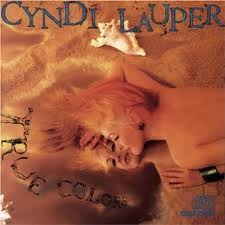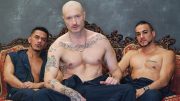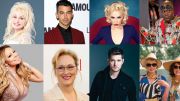Twenty-five years ago, Cyndi Lauper’s “True Colors” shined through – on the radio, and in the hearts of so many. It was in the midst of the horrifying AIDS epidemic when she lost her dear gay friend, came across the song, and made it into a hit that comforted millions.
“I was very much in mourning,” the 58-year-old icon recalls of the chart-topper, the title track from her 1986 album, in our recent chat. “I was sad and I wanted to be able to do something. He wanted me to sing a song for him, and I had written one (“Boy Blue”). That didn’t work out too good, because I wrote about my feelings – which were big.”
But “True Colors,” originally written by Billy Steinberg and Tom Kelly for Anne Murray, spoke to her. Years later, it’s not just a song; it’s an anthem for everything that Lauper – a selfless, admirable activist for the community – stands for. As part of her True Colors Fund, she launched a project last year, the Give a Damn Campaign, to create awareness of LGBT discrimination with the help of high-profile celebrities, many of them heterosexual.
“In any civil rights movement, you need everybody,” Lauper says with heartfelt indignation. “That’s how you win. You need your straight allies.”
She had them on the tour, also named after the song, which ran for two years and featured Debbie Harry, Margaret Cho, The B-52s and Erasure. Now, Lauper’s showing her support with a shelter, recently opened in Central Harlem, to offer supportive housing for LGBT youth without any place to go, who may have been thrown out of their own homes. A mother herself, Lauper can’t fathom a parent disowning their child.
“Parental love should be unconditional,” she says. “Love your kid for who they are or who they aren’t. The parent/child bond should never be broken.”
But if it is, they have a place that loves them: the True Colors Residence. Lauper’s quick not to take all the credit, though; she names off a list of important key players who made this – a six-story, 30-bed facility, the first permanent establishment of its kind in New York – happen. Her manager, Lisa Barbaris, is one of them, along with the West End Intergenerational Residence, a non-profit focused on providing housing for homeless families and the elderly.
“I was the famous person there, but a lot of people did a lot of work,” she says of the shelter’s official opening in September. “I was just the one who cut the ribbon. It’s an interesting project because it’s a low-income housing project, which makes it work on so many other levels. It’s kind of fabulous.”
Same could be said for Lauper’s career, officially launching in the early ’80s – during an out-of-control house party that had the singer persuading her parents to whoop it up, all for a little single called “Girls Just Want to Have Fun” off her 1983 debut She’s So Unusual – as the New Yorker shot to superstardom instantly with funky-punky sunburst hair (one of many colors we’d see throughout the decade) and her outrageous fashion sense. She, like Madonna, was Gaga before Gaga existed. Lauper had the eccentricity, and she certainly had the hits.
There was the sweet charm of got-your-back ballad “Time After Time,” a song still in heavy rotation nearly 30 years later. “A magical time,” she calls it now. “She Bop” blasted myths of masturbation, promoting it as something just as routine as brushing your teeth. The video – and “all my friends and family that showed up in the video with me” – is what she remembers most.
There was also “We Are the World,” the all-star charity single – a monster one, at that – featuring Michael Jackson, Diana Ross and Lauper. Her fondest memory: “That I walked in with almost the same jacket that Michael had on, and I changed it really quick. But I was upset anyway because I had the flakes in my hair, because I was doing that performance-art piece for the American Music Awards and didn’t have time to clean up. I was having a moment.”
In the next three decades, Lauper would have many more moments. She would win Grammys. Have a son. Sing to a disgruntled group of flyers at an airline terminal. Flub the “Star-Spangled Banner,” and gracefully recover from it, as she did recently before the US Open just this past September.
Looking back, what would she have told her younger, more “unusual” self? “I know I said all the wrong things to the right people,” she laughs, “but probably not listen all the time to everything everybody told me. That there was a bigger world out there.”
A world she’s still happy to be a part of. “I’ve been told, ‘No, it’ll never work.’ It’s always the same. But I’m still working.”
Something she was told she could never do – by Sony, her label at the time – was the blues. She sure showed them. “To Memphis, With Love” is Lauper’s latest release, a live CD/DVD combo that captures one night of her most recent, and one of the more extensive, tours in her career. The songs performed are off last year’s “Memphis Blues,” her baby she’d been working toward her whole career. Her 11th studio album, the project scored the top spot of the Billboard Blues Chart for 14 consecutive weeks.
“It’s the spirit of the blues that propels you into an otherworldly state,” she says. “Basically, that’s what you would hope for from music.”
While editing the docu-style DVD, filmed at The Warehouse in Memphis and featuring special guests Jonny Lang and Tracy Nelson, Lauper had to do the unthinkable for anyone who can’t stand mirrors: look at herself for hours on end.
“Once you get over the fact that you thought you looked different but this is what you really look like, it’s fine,” Lauper laughs. “It’s always that way. You can’t ever take yourself seriously.”
Next up for Lauper? New original music, which she’s currently working on; writing for the Broadway show “Kinky Boots”; and a memoir that’s still in the early stages. A reality show, set to air early next year, is also in the works.
Lauper’s also determined to get the True Colors Tour, on hold because of the economy, back off the ground.
“It’s going to take a minute to figure out how to do it right but I’ll get it back,” she says. “I always wanted it to be a little party, a real festival in one place – different stages, food and music. But I don’t know really how to do that. I’m not a businessperson; I’m an artist that wanted an inclusive tour with straight people and gay people and transgender people – everybody mixed together. That was my big dream.”
And her true colors, shining through.








